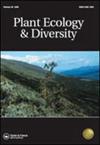不同辐射条件下附生仙人掌的解剖与生长
IF 1.6
4区 生物学
Q2 PLANT SCIENCES
引用次数: 0
摘要
摘要背景植物发展出对阳光或阴影暴露具有耐受性的机制,了解它们的反应可能有助于制定保护自然种群及其繁殖的策略。目的研究遮荫对叶下珠生态生理和解剖结构的影响,以确定其可塑性和耐受性。方法将叶下珠标本分别置于35%、75%和85%的遮光条件下60天。对植物的生长特性、叶枝解剖和含水量进行了定量和比较。结果所有受阳光照射和35%遮荫的个体均已死亡。85%的遮荫产生了最高的新鲜和干燥茎质量。较高的遮荫对生物量向茎或根的分配或相对生长速率、净同化率、叶面积比或含水量没有影响。叶枝的厚度随着遮荫的增加而增加。在遮光75%的处理中,观察到两个表面的气孔密度最高。结论叶下珠是一种需要遮荫才能生存的接生植物。它的主要策略似乎是在更荫蔽的条件下,在其叶枝中积累更多的水分,从而刺激植物生长。本文章由计算机程序翻译,如有差异,请以英文原文为准。
Anatomy and growth of the epiphytic cactus Epiphyllum phyllanthus under different radiation conditions
ABSTRACT Background Plants develop mechanisms that confer tolerance to sun or shade exposure and the knowledge of their responses may help to devise strategies for the conservation of natural populations and their propagation. Aims We study the effect of shading on the ecophysiology and anatomy of Epiphyllum phyllanthus to determine its plasticity and tolerance. Methods Specimens of E. phyllanthus were subjected to full sun, 35%, 75%, and 85% shading for 60 days. The growth characteristics, phylloclade anatomy and water content in the plants were quantified and compared. Results All individuals subjected to full sun and 35% shading had died. A shading of 85% produced the highest fresh and dry mass of the stems. Higher shading caused no effect in the allocation of biomass to stems or roots or on the relative growth rate, net assimilation rate, leaf area ratio or water content. The thickness of the phylloclade increased with increased shading. The highest stomatal density on both surfaces was observed in the treatment with 75% shading. Conclusion E. phyllanthus is a sciophytic plant that requires shade to survive. Its main strategy appears to be the greater accumulation of water in its phylloclade under more shaded conditions, which stimulates plant growth.
求助全文
通过发布文献求助,成功后即可免费获取论文全文。
去求助
来源期刊

Plant Ecology & Diversity
PLANT SCIENCES-
CiteScore
3.30
自引率
0.00%
发文量
26
审稿时长
3 months
期刊介绍:
Plant Ecology and Diversity is an international journal for communicating results and novel ideas in plant science, in print and on-line, six times a year. All areas of plant biology relating to ecology, evolution and diversity are of interest, including those which explicitly deal with today''s highly topical themes, such as biodiversity, conservation and global change. We consider submissions that address fundamental questions which are pertinent to contemporary plant science. Articles concerning extreme environments world-wide are particularly welcome.
Plant Ecology and Diversity considers for publication original research articles, short communications, reviews, and scientific correspondence that explore thought-provoking ideas.
To aid redressing ‘publication bias’ the journal is unique in reporting, in the form of short communications, ‘negative results’ and ‘repeat experiments’ that test ecological theories experimentally, in theoretically flawless and methodologically sound papers. Research reviews and method papers, are also encouraged.
Plant Ecology & Diversity publishes high-quality and topical research that demonstrates solid scholarship. As such, the journal does not publish purely descriptive papers. Submissions are required to focus on research topics that are broad in their scope and thus provide new insights and contribute to theory. The original research should address clear hypotheses that test theory or questions and offer new insights on topics of interest to an international readership.
 求助内容:
求助内容: 应助结果提醒方式:
应助结果提醒方式:


